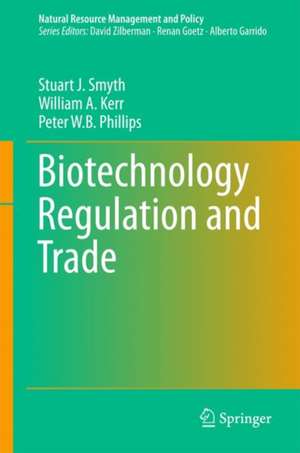Biotechnology Regulation and Trade: Natural Resource Management and Policy, cartea 51
Autor Stuart J. Smyth, William A. Kerr, Peter W. B Phillipsen Limba Engleză Hardback – 10 mar 2017
| Toate formatele și edițiile | Preț | Express |
|---|---|---|
| Paperback (1) | 726.85 lei 6-8 săpt. | |
| Springer International Publishing – 21 iul 2018 | 726.85 lei 6-8 săpt. | |
| Hardback (1) | 732.84 lei 6-8 săpt. | |
| Springer International Publishing – 10 mar 2017 | 732.84 lei 6-8 săpt. |
Din seria Natural Resource Management and Policy
- 18%
 Preț: 1226.24 lei
Preț: 1226.24 lei - 18%
 Preț: 958.56 lei
Preț: 958.56 lei - 18%
 Preț: 958.38 lei
Preț: 958.38 lei - 18%
 Preț: 1223.74 lei
Preț: 1223.74 lei - 18%
 Preț: 948.29 lei
Preț: 948.29 lei - 15%
 Preț: 641.03 lei
Preț: 641.03 lei - 18%
 Preț: 954.93 lei
Preț: 954.93 lei - 15%
 Preț: 646.43 lei
Preț: 646.43 lei - 18%
 Preț: 955.08 lei
Preț: 955.08 lei - 18%
 Preț: 1233.37 lei
Preț: 1233.37 lei - 15%
 Preț: 651.84 lei
Preț: 651.84 lei - 18%
 Preț: 951.47 lei
Preț: 951.47 lei - 18%
 Preț: 1229.73 lei
Preț: 1229.73 lei - 18%
 Preț: 1229.28 lei
Preț: 1229.28 lei - 15%
 Preț: 643.00 lei
Preț: 643.00 lei - 18%
 Preț: 1237.14 lei
Preț: 1237.14 lei - 15%
 Preț: 645.79 lei
Preț: 645.79 lei - 15%
 Preț: 650.86 lei
Preț: 650.86 lei - 15%
 Preț: 653.14 lei
Preț: 653.14 lei - 18%
 Preț: 1233.52 lei
Preț: 1233.52 lei - 18%
 Preț: 1233.20 lei
Preț: 1233.20 lei - 18%
 Preț: 950.96 lei
Preț: 950.96 lei - 18%
 Preț: 1242.21 lei
Preț: 1242.21 lei - 18%
 Preț: 1222.01 lei
Preț: 1222.01 lei - 18%
 Preț: 951.29 lei
Preț: 951.29 lei - 18%
 Preț: 1551.11 lei
Preț: 1551.11 lei
Preț: 732.84 lei
Preț vechi: 893.71 lei
-18% Nou
Puncte Express: 1099
Preț estimativ în valută:
140.25€ • 145.88$ • 115.78£
140.25€ • 145.88$ • 115.78£
Carte tipărită la comandă
Livrare economică 15-29 aprilie
Preluare comenzi: 021 569.72.76
Specificații
ISBN-13: 9783319532936
ISBN-10: 3319532936
Pagini: 275
Ilustrații: XXI, 275 p. 18 illus.
Dimensiuni: 155 x 235 x 18 mm
Greutate: 0.59 kg
Ediția:1st ed. 2017
Editura: Springer International Publishing
Colecția Springer
Seria Natural Resource Management and Policy
Locul publicării:Cham, Switzerland
ISBN-10: 3319532936
Pagini: 275
Ilustrații: XXI, 275 p. 18 illus.
Dimensiuni: 155 x 235 x 18 mm
Greutate: 0.59 kg
Ediția:1st ed. 2017
Editura: Springer International Publishing
Colecția Springer
Seria Natural Resource Management and Policy
Locul publicării:Cham, Switzerland
Cuprins
Section I: The Changing Dynamics of Institutional Architecture.- 1. International Governance in the 21st Century.- 2. Governance Challenges from Transformative Technologies.- 3. Barriers to Trade and Investment Impacts.- 4. Managing Trade in Products of Biotechnology.- 5. International Treaty Precedence.- Section II: Present Pulse of the International Market.- 6. Benefits of Genetically Modified Crops.- 7. The Regulation of Genetically Modified Crops in Canada.- 8. Canadian Canola: A Case Study in Profitable Genetic Innovation.- 9. Coexistence and International Commodity Trade.- 10. Global Trade Impacts from Low Level Presence.- 11. The World Trade Organization and Low Level Presence.- 12. Food Security and the Evaluation of Risk.- 13. Innovation and Utility: The Challenges of Winners and Losers.- Section III: Breaking the Gridlock.- 14. Accelerating Genetically Modified Crop.- 15. Governance Constraints on Improving Food Security.- 16. The Cost of Socio-Economic Biosafety Assessments.- 17. Institutions, Trade and Food Security.- 18. The Future of Food Security.
Textul de pe ultima copertă
This book discusses the regulatory and trade challenges facing the global adoption of biotechnological products and offers strategies for overcoming these obstacles and moving towards greater global food security. The first section of the book establishes the context of the conflict, discussing the challenges of global governance, international trade, and the history of regulation of genetically modified (GM) crops. In this section, the authors emphasize the shift from exclusively science-based regulation to the more socio-economically focused framework established by the Cartagena Protocol on Biosafety, which was adopted in 2000. The second section of the book provides a snapshot of the current state of international GM crop adoption and regulation, highlighting the US, Canada, and the EU. The final section of the book identifies options for breaking the gridlock of regulation and trade that presently exist. This book adds to the current literature by providing new information about innovative agricultural technologies and encouraging debate by providing an alternative to the narratives espoused by environmental non-governmental organizations. This book will appeal to students of economics, political science, and policy analysis, as well as members of regulatory agencies and agricultural industry firms.
Caracteristici
Highlights the regulatory and trade challenges to improving food security and offers strategic responses to these challenges Discusses the current state of international GM crop adoption, using Canada as a case study of efficient, science-based regulation Summarizes the global economic, environmental, and human health benefits from the adoption, production and consumption of genetically modified crops Includes supplementary material: sn.pub/extras

















